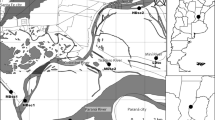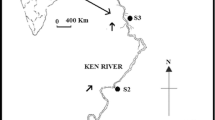Abstract
Data from 25 sites were used to evaluate associations between macroinvertebrate assemblages on large woody debris (snags) and environmental variables in the lower San Joaquin and Sacramento River drainages in California as part of the U.S. Geological Survey's National Water Quality Assessment Program. Samples were collected from 1993 to 1995 in the San Joaquin River drainage and in 1996 and 1997 in the Sacramento River drainage. Macroinvertebrate taxa were aggregated to the family (or higher) level of taxonomic organization, resulting in 39 taxa for analyses. Only the 31 most common taxa were used for two-way indicator species analysis (TWINSPAN) and canonical correspondence analysis (CCA). TWINSPAN analysis defined four groups of snag samples on the basis of macroinvertebrate assemblages. Analysis of variance identified differences in environmental and biotic characteristics among the groups. These results combined with the results of CCA indicated that mean dominant substrate type, gradient, specific conductance, water temperature, percentage of the basin in agricultural land use, percentage of the basin in combined agricultural and urban land uses, and elevation were important factors in explaining assemblage structure. Macroinvertebrate assemblages on snags may be useful in family level bioassessments of environmental conditions in valley floor habitats.
Similar content being viewed by others
References
Bottorff, R.L. and Knight, A.W.: 1989, ‘Strongly (Plecoptera) feeding modes; variation along a California river continuum’ in: Proceedings of the Californian riparian systems conference: protection, management, and restoration for the 1990s, Abell, D.L. (ed.), U.S. Forest Service, Gen. Tech. Rept. PWS-110, Pacific Southwest Forest and Range Experiment Station, Berkeley, California, pp. 235–241.
Bournaud, M., Cellot, B., Richoux, P. and Berrabou, A.: 1996, ‘Macroinvertebrate community structure and environmental characteristics along a large river: congruity of patterns for identification to species or family’ J. N. Amer. Benthol. Soc. 15, 232–253.
Bowman, M.F. and Bailey, R.C.: 1997, ‘Does taxonomic resolution affect the multivariate description of the structure of freshwater benthic macroinvertebrate communities?’ Can. J. Fish. Aquat. Sci. 54, 1802–1807.
Brown, L.R.: 1996, Aquatic biology of the San Joaquin-Tulare Basins, California: analysis of available data through 1992’ U.S. Geological Survey, Water-supply Paper2471, Denver, Colorado, 89 pp.
Brown, L.R. and Short, T.M.: 1999, Biological, habitat and water quality conditions in the upper Merced River drainage, Yosemit National Park, 1993–1996, U.S. Geological Survey, Water Resources Investigation Report 99–4088, Denver, Colorado, 56pp.
Cuffney, T.F., Gurts, M.E. and Meador, M.R.: 1993, Methods for collecting benthic invertebrate samples as part of the National Water-Quality Assessment Program, U.S. Geological Survey, Open-File Report 93–406, Raleigh, NC, 66 pp.
Domagalski, J.L.: 1996. ‘Pesticides and pesticide degradation products in stormwater runoff: Sacramento River Basin, California’ J Amer. Water Res. Assoc. 32, 953–964.
Domagalski J.L., Knifong D.L., McCoy, D.E., Dilearies, P.D., Dawson, B.J. and Majewski, M.S.: 1998, Water quality assessment of the Sacramento River Basin, California-environmental setting and study design, Water-Resources Investigations Report 97–4254, U.S. Geological Survey, Sacramento, CA, 31 pp.
Erman, N.: 1996, ‘Status of aquatic invertebrates’ in: Sierra Nevada Ecosystem Project: final report to Congress, vol. II, Assessments and scientific basis for management options, Centers for Water and Widland Resources, University of California, Davis, CA, 987–1008.
Fore, L.S., Karr, J.R. and Wisseman, R.W.: 1996, ‘Assessing invertebrate responses to human activities: evaluating alternative approaches’ J. N. Amer. Benthol. Soc. 15, 212–231.
Gromberg, J.M., Dubrovsky, N.M., Kratzer, C.R., Domagalski, J.L., Brown, L.R. and Burow, K.R.: 1998, Environmental setting of the San Joaquin-Tulare Basins, California, Water-Resources Investigations Report 97–4205, U.S. Geological Survey, Sacramento, CA, 45 pp.
Harrington, J. M.: 1996, California stream bioassessment procedures, California Department of Fish and Game, Water Pollution Control Laboratory, Rancho Cordova, CA.
Hawkins, C.P., Hogue, J.N., Decker, L.M. and Feminella, J.W.: 1997, ‘Channel morphology, water temperature and assemblage structure of stream insects’ J. N. Amer. Benthol. Soc. 16, 728–749.
Hazel, C.R. and Kelley, D.W.: 1966, ‘Zoobenthos of the Sacramento-San Joaquin elta' in: Ecological studies of the Sacramento-San Joaquin Estuary, Part I, zooplankton, zoobenthos and fishes of San Pablo and Suisun Bays, zooplankton and zoobenthos of the Delta, Kelley, D.W. (ed.), California Department of Fish and Game, Fish Bulletin 133, 113–133.
Hill, M.O.: 1979, ‘TWINSPAN-a FORTRAN program for arranging multivariate data in an ordered two-way table by classification of the individuals and attributes’ Ecology and Sytematics, Cornell University, Ithaca, 90 pp.
Jongman, R.H.G., ter Braak, C.J.F. and Tongeren, O.F.R.: 1995, Data analysis in community and landscape ecology, Cambridge University Press, Cambridges, 299 pp.
Leland, H.V. and Fend, S.V.: 1998, ‘Benthic invertegrate distributions in the San Joaquin River, California, in relation to physical and chemical factors’ Can J. Fish. Aquat. Sci. 55, 1051–1067.
Lenat, D.R.: 1988, ‘Water quality assessment of streams using a qualitative collection method for benthic macroinvertebrates’ J. N. Amer. Benthol. Soc. 7, 222–233.
Meador, M.R., Hupp, C.R., Cuffney, T.F.and Gurts, M.E.: 1993, Methods for characterizing stream habitat as part of the National Water-Quality Assessment Program, U.S. Geological Survey, Open-File Report 93–408, Raleigh, NC, 48 pp.
Ohio Environmental Protection Agency: 1988, Biological criteria for the protection of aquatic life, Volumes I-III, Division of Water Quality Monitoring, Surface Water Section, Columbus, OH, 351 pp.
Omernick, J.M.: 1987, ‘Ecoregions of the conterminous United States’ Ann. Assoc. Amer. Geograph. 77, 118–125.
Omernik, J.M. and Bailey, R.G.: 1997, ‘Distinguishing between watersheds and ecoregions’ J. Amer. Water Res. Assoc. 33935–949.
Panshin, S.Y., Dubrovsky, N.M., Gronberg, J.M. and Domagalski, J.L.: 1998, Occurrence and distribution of dissolved pesticides in he San Joaquin River Basin, California, Water-Resources Investigations Report 98–4032, U.S. Geological Survey, Sacramento, CA, 88 pp.
Plafkin, J.L., Barbour, M.T., Porter, K.D., Gross, S.K. and Hughes, R.M.: 1989, Rapid bioassessment protocols in streams and rivers: benthic macroinvertebrates and fish, EPA/444/4-89-001, U.S. Environmental Protection Agency, Office of Water Regulation and Standards, Washington, DC.
Resh, H.V. and Uzicker, J.D.: 1975, ‘Water quality monitoring and aquatic organism: the importance of species investigations’ J. Water Pollut. Bull. 24, 9–19.
ter Braak, C.J.F.: 1986, ‘Canonical correspondence analysis: a new eigenvector method for multivarate direct gradiant analysis’ Ecology 67, 1167–1179.
ter Braak, C.J.F.: 1987, CANOCO: a FORTRAN program for canonical community ordination by (partial) (detrended) (canonical) correspondence analysis, principal component analysis and redundancy analysis. TNO Institute of Applied Computer Science, Wageningen.
Wilkinson, L. and Coward, M.: 1998, ‘Linear models III: general linear models’ in: SYSTAT 8.0 Statistics, Wilkinson, L. (ed.), SPSS Inc., Chicago, IL, pp. 457–516.
Wilkinson, L., Engleman, L. and Marcantonio, R.: 1998, ‘Correlation, similarities and distance measures’ in: SYSTAT 8.0 Statistics, Wilkinson, L. (ed.), SPSS Inc., Chicago, IL, pp. 115–148.
Author information
Authors and Affiliations
Rights and permissions
About this article
Cite this article
Brown, L.R., May, J.T. Macroinvertebrate Assemblages on Woody Debris and Their Relations with Environmental Variables in the Lower Sacramento and San Joaquin River Drainages, California. Environ Monit Assess 64, 311–329 (2000). https://doi.org/10.1023/A:1006482800472
Issue Date:
DOI: https://doi.org/10.1023/A:1006482800472




